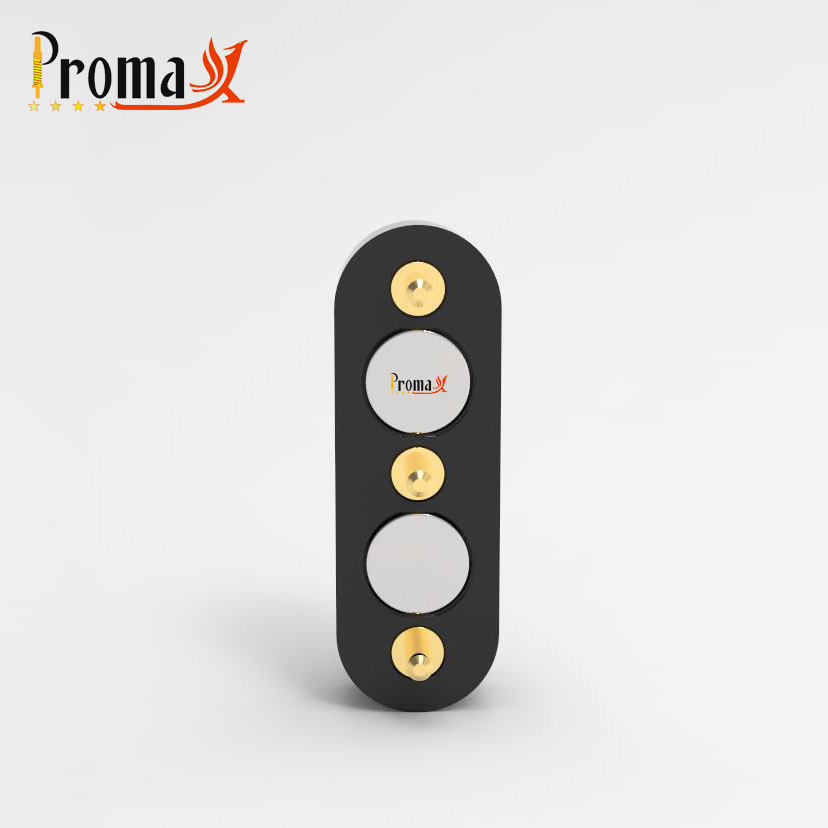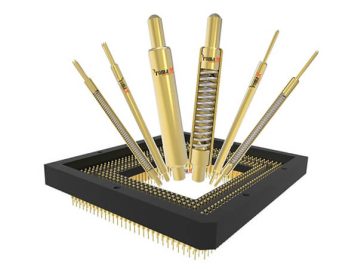3-pin Pogo connectors, though less known, are vital in electronics for seamless electrical signal flow through their spring-loaded pins. But why is the right choice crucial?
Selecting the correct 3-pin Pogo connector is more than a technicality; it’s pivotal for your electronics project. A wrong choice can lead to inefficiencies, extra costs, and future issues.
This article is a step-by-step exploration of 3-pin Pogo connectors. We’ll start with the basics, understanding their functionality and types. We’ll also delve into their applications and advantages.
To aid your decision-making, we’ll thoroughly examine the essential factors for choosing the appropriate connector, providing you with the knowledge and confidence to make informed decisions.
Understanding 3-Pin Pogo Connectors
The Basics
Definition and Functionality
3-pin Pogo connectors, modest yet vital in electronics, serve as communication bridges within devices. Comprising three spring-loaded pins, they extend and retract, creating a secure electrical connection with a matching socket.Functionality: When these pins touch, electrical signals flow freely, ensuring your device operates smoothly, like plugging in your earphones.
A Brief Historical Background
Pogo connectors trace their origins to the mid-20th century, initially for military and aerospace applications due to their reliability and durability. As technology advanced, their use expanded across diverse industries.
Common Applications and Industries
Electronics and PCB Manufacturing
Pogo connectors serve as the handshake that ensures your electronic devices function correctly. They are crucial for testing and programming printed circuit boards (PCBs) during manufacturing, as the final quality check before your device reaches you.
Automotive
Pogo connectors play a more significant role in your car than you might realize. They are used for tasks such as testing the Engine Control Unit (ECU) and vehicle diagnostics. Their durability is vital in the demanding automotive environment.
Aerospace
Reliability is paramount in the aerospace industry, so the Pogo connectors are essential for various applications, including data transfer in space missions and maintaining connections in aviation technology. They’ve demonstrated their worth in extreme conditions.
Medical Devices
In medical equipment, precision and reliability are essential. Pogo connectors are crucial in devices such as diagnostic tools and patient monitoring systems, ensuring accurate data transmission and, most importantly, patient safety.
Advantages of 3-Pin Pogo Connectors
Reliable Electrical Contact
Pogo connectors excel at creating consistent and dependable electrical connections, ensuring smooth data transfer in your car, smartphone, or medical device.
Versatility in Designs
Pogo connectors are like chameleons in the connector world, offering a variety of designs that manufacturers can customize for specific needs. This adaptability fosters innovation, delivering unique solutions for different industries.
Easy Installation
Installing Pogo connectors is as straightforward as assembling a puzzle. Their user-friendliness makes them an appealing choice for manufacturers and technicians, reducing downtime and maintenance efforts.

Types of 3-Pin Pogo Connectors
Diverse Varieties
Spring-Loaded vs. Magnetic Connectors
- Spring-Loaded Connectors: These are the workhorses of Pogo connectors, using springs for contact. They’re simple and reliable, suitable for various applications.
- Magnetic Connectors: Magnetic connectors employ magnets for alignment and contact, providing user-friendly and secure connections in specific situations, like the magnets on your fridge.
Materials (Brass, Stainless Steel, etc.)
Pogo connectors can be crafted from different materials, with brass and stainless steel being common choices:
- Brass Connectors: Known for good electrical conductivity and cost-effectiveness.
- Stainless Steel Connectors: Favored for their durability and corrosion resistance, ideal for demanding environments.
Size and Shape Variations
Pogo connectors come in diverse sizes and shapes, impacting their suitability for specific applications:
- Smaller Connectors: Perfect for compact devices with limited space, fitting like precision instruments.
- Larger Connectors: Essential for heavy-duty applications requiring a robust connection, like heavy machinery on a construction site.
Specific Applications
Now, let’s explore where these connectors find their use:
Board-to-Board Connections
Pogo connectors are the go-to solution for linking printed circuit boards (PCBs), functioning like the handshake between your device’s brain and its limbs. This simplifies assembly and maintenance.
Battery Charging
When you charge your smartphone, Pogo connectors play a vital role. They’re widely used in consumer electronics, guaranteeing a speedy and dependable power connection.
Test and Measurement
Equipment For precise measurements, Pogo connectors excel. They’re vital in devices like oscilloscopes and multimeters, ensuring dependable readings through a solid connection.
How To Choose the Right 3Pin Pogo Connector Type?
To choose the best fit Pogo connector, think of it like tailoring a suit – you need a perfect fit. Consider these factors:
Tailoring to Electrical Requirements
Understand your project’s electrical needs, including voltage and current requirements. Ensure the connector can handle the power levels without safety concerns.
Considering Mechanical Dimensions
Size matters! Ensure the connector seamlessly fits into your device or PCB without causing conflicts. Size mismatches can lead to installation problems and potential damage.
Adhering to Environmental Conditions
Environmental conditions can significantly impact connector performance. Think about temperature, moisture, and vibration tolerance. Is the connector going into a rugged environment? It should be up to the task.

Factors to Consider When Choosing the Right Connector
Selecting the appropriate 3-pin Pogo connector involves a thorough evaluation of essential factors. Let’s break down these crucial considerations:
Electrical Compatibility
Voltage and Current Ratings
Before choosing a Pogo connector, grasp your project’s electrical requirements. What voltage and current ratings does your application need?
Ensuring the connector can handle the expected power levels is vital, similar to assuring your car’s engine matches your desired speed.
Signal Integrity
For applications involving data transfer, preserving signal integrity is paramount. Seek connectors with features like low signal loss and electromagnetic shielding. This ensures accurate and interference-free data transmission, like maintaining a crystal-clear phone call.
Mechanical Suitability
Size, Shape, and Pitch
Choosing a Pogo connector is akin to selecting the right puzzle piece. Ensure the connector aligns with your device’s mechanical specifications without causing conflicts. Mismatched size or shape can lead to installation issues, which are best avoided.
Mating and Unmating Cycles
Think about how often you’ll connect and disconnect the connector. If it’s frequent, choose a high-durability connector, similar to picking a sturdy light switch that won’t wear out with frequent use.
Environmental Resilience
Temperature and Moisture Resistance
Environmental conditions impact connector performance. Consider where and how you’ll use the connector. Will it endure extreme temperatures or high humidity?
Connectors designed for specific conditions ensure reliability, just like choosing the appropriate clothing for the weather – you wouldn’t wear a heavy coat in summer.
Vibration and Shock Tolerance
In applications with mechanical stress, such as vehicles, connectors must endure vibration and shock without losing contact. It’s like expecting shock absorbers in a car to handle bumps in the road.
Reliability and Durability
Materials and Coatings
The materials and coatings used in a connector significantly affect its durability. High-quality materials, such as stainless steel, offer better resistance to corrosion and wear, much like a tool made from high-quality steel – it lasts longer and performs better.
Quality Standards
Choose connectors that conform to industry quality standards and certifications. It guarantees that the connectors meet defined performance and safety criteria, similar to buying products with a trusted quality mark – you know they meet specific standards.
Budgetary Considerations
Cost vs. Long-Term Value
Consider the cost and the long-term benefits of a reliable connector for your project. Investing more in a quality connector can lead to reduced maintenance and replacements, similar to buying a durable, high-quality tool.
Customization Costs
For unique applications, custom connectors might be needed. Be ready to evaluate the costs and lead times for customization, like getting a tailor-made suit that fits your needs perfectly.
With these factors in mind, you’re ready to make an informed choice when selecting a 3-pin Pogo connector for your project.

How to Choose the Right 3-Pin Pogo Connector? Step by Step
Assessing Your Specific Needs
Identifying Application Requirements
Start by understanding your project’s electrical requirements. What voltage and current specifications does it need? Think of it as creating a shopping list – you need to know what you’re looking for.
Defining Key Parameters
Determine the critical size, shape, and environmental factors your connector must meet. These are the blueprints for your connector, defining how it should fit and function in your project.
Researching Available Options
Manufacturer and Supplier Evaluation
Research and evaluate the reputation of manufacturers and suppliers. Established and reputable companies, like PromaxPogoPin, often provide high-quality products. It’s like checking restaurant reviews before choosing – you want a trusted source.
Product Reviews and Recommendations
Seek product reviews and recommendations from industry experts or peers. Real-world experiences offer valuable insights. It’s like getting advice from friends before making a significant purchase – you want to hear from people who’ve been there.
Avoiding Common Selection Pitfalls
Overlooking Environmental Factors
Environmental conditions significantly affect connector performance. Therefore, it’s essential to select connectors that can withstand temperature variations, moisture, and vibrations.
Think of it as picking appropriate clothing for the weather; being unprepared is not ideal.
Ignoring Long-Term Reliability
Emphasize long-term reliability, not just cost. Choosing connectors solely based on price can result in frequent replacements and higher expenses.
It’s similar to buying inexpensive shoes that quickly wear out; they might seem like a deal at first but end up costing more over time.
Underestimating Budgetary Constraints
Prioritize both quality and affordability when choosing a connector. Ensure it’s reliable while staying within budget. Just as you manage your monthly expenses, aim for the best value without overspending.
By following these steps and avoiding common mistakes, you’ll effectively select the ideal 3-pin Pogo connector for your project without any unexpected issues.

Conclusion
Choosing the appropriate 3-pin Pogo connector is crucial for project success, whether in medical devices, automotive systems, or consumer electronics. It significantly impacts reliability and functionality.
We’ve covered various aspects of 3-pin Pogo connectors, from basics to uses, emphasizing electrical compatibility, mechanical fit, environmental resilience, reliability, and budget considerations. The best-fit connector is like the cornerstone, ensuring structural stability.
Selecting the suitable 3-pin Pogo connector is both technical and strategic. It lays the foundation for your project’s success, saving time, money, and future complications. Use this knowledge to choose the ideal connector that suits your needs.
FAQs
Can 3-Pin Pogo Connectors Handle High-Frequency Data Signals?
Yes, 3-pin Pogo connectors can manage high-frequency data signals. Choose connectors with low signal loss and electromagnetic shielding for optimal performance in high-frequency applications.
Can Pogo Connectors Withstand Extreme Outdoor Temperatures?
Yes, Pogo connectors are suitable for outdoor use with extreme temperature variations. Opt for connectors to handle such conditions, ensuring temperature and moisture resistance.
What Safety Considerations Apply to Pogo Connectors in Medical Devices?
Safety is critical when using Pogo connectors in medical devices. Select connectors meeting industry safety and reliability standards, including biocompatibility for patient safety.
Can Pogo Connectors Function in Underwater Environments?
Pogo connectors can operate underwater with specialized waterproof and corrosion-resistant options. These connectors prevent water intrusion, maintaining electrical connections.
How to Clean and Maintain Pogo Connectors for Best Performance?
Regularly clean Pogo connectors using appropriate methods and solutions to remove dust and debris. Avoid abrasive materials and follow the manufacturer’s maintenance guidelines.
Can Pogo Connectors Support High-Power Applications?
Pogo connectors are suitable for high-power applications such as heavy machinery and industrial equipment. Choose connectors with the required voltage and current ratings and ensure durability for these demanding uses.
 Over 15 Years of Expertise
Over 15 Years of Expertise FREE samples provided to ensure product satisfaction
FREE samples provided to ensure product satisfaction Rapid Turnaround: Mass Production Complete in 15 - 20 Days
Rapid Turnaround: Mass Production Complete in 15 - 20 Days











